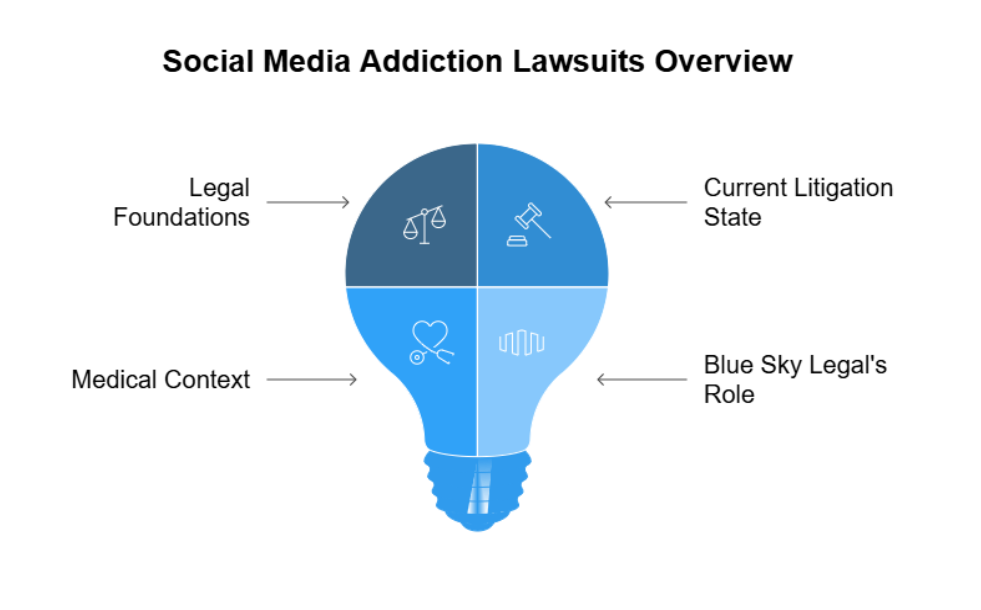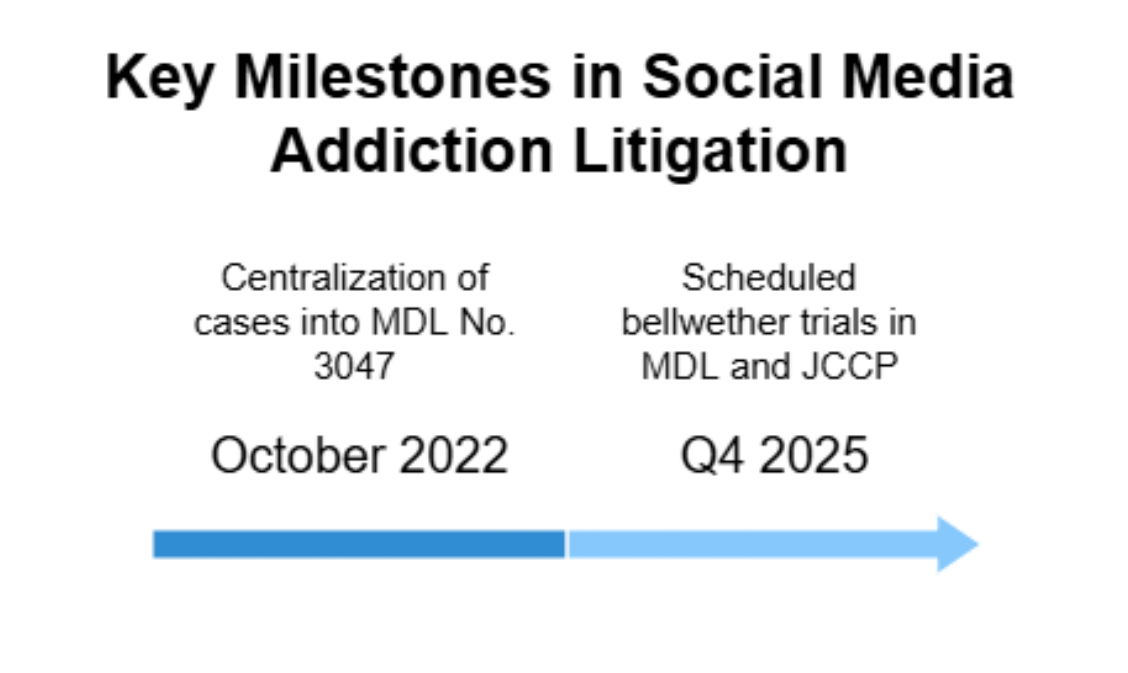Social Media Addiction Mass Tort Lawsuits: Legal Landscape & Emerging Trends
A Strategic White Paper from Blue Sky Legal
Social media has become an integral part of youth life – and now a growing source of legal exposure for tech giants. Social media addiction lawsuits have surged into a major mass tort, alleging that companies like Meta (Facebook/Instagram), Snap (Snapchat), TikTok, Google (YouTube), and others intentionally designed their platforms to be addictive for minors without adequate warnings of the harms. These cases are being consolidated into multidistrict and state court proceedings, drawing comparisons to tobacco or opioid litigation in their scale and public health implications.
This white paper provides a structured overview of the legal foundations for these lawsuits, the current state of litigation (including key cases, firms, and court rulings), trends in how courts are handling class actions and multidistrict litigation (MDL) activity, and the medical context of harms linked to excessive social media use in adolescents. We also outline Blue Sky Legal’s intake criteria for potential plaintiffs and conclude with how Blue Sky Legal is uniquely positioned, through prior experience and a performance-based model, to capitalize on this emerging litigation for investors and partner firms.

Legal Foundation: Product Liability, Failure to Warn & Design Defects
Product Liability Theories: These lawsuits contend that social media platforms are consumer products rendered unreasonably dangerous by design. Plaintiffs argue that companies engineered their apps to maximize screen time among youth, embedding addictive features like infinite scroll, algorithmic content curation, and push notifications. This gives rise to design defect claims, as the features were allegedly created to induce compulsive behavior. Failure-to-warn claims assert that platforms knew about potential psychological harms but failed to disclose those risks to users or their parents. Since the users were minors, plaintiffs argue the companies owed a heightened duty of care.
Evidence of Defective Design: Key design elements cited include endless feeds, algorithmically recommended content, disappearing stories, push notifications, and minimal age gating. Plaintiffs allege these features were knowingly engineered to keep users engaged, exploiting the neurodevelopmental vulnerabilities of minors for profit. These claims are supported by internal research and whistleblower testimony indicating that social media companies were aware of the potential psychological impacts yet continued to prioritize engagement metrics over safety.
Failure to Warn: Despite evidence of harms, social media companies provided no safety labels, parental warnings, or usage guidelines. Unlike physical products that carry risk disclosures, these apps were marketed as benign communication tools. Lawsuits argue this omission constitutes negligence and a violation of basic product safety principles. Plaintiffs assert that had appropriate warnings and controls been in place, many of the injuries now being litigated could have been prevented.
Overcoming Section 230: Plaintiffs carefully distinguish between platform content (protected under Section 230) and platform design (which is not). Courts have begun recognizing this distinction, allowing failure-to-warn and design defect claims to proceed even where content-based claims are dismissed. Likewise, First Amendment defenses have not blocked these claims, as algorithmic targeting is treated as conduct rather than speech. This is a major inflection point for product liability law as applied to digital services.

Current State of the Litigation
Federal MDL: In October 2022, the Judicial Panel on Multidistrict Litigation centralized social media addiction cases into MDL No. 3047 in the Northern District of California, overseen by Judge Yvonne Gonzalez Rogers. The MDL now includes over 1,700 cases, representing minors, parents, and institutional plaintiffs like school districts. These coordinated proceedings aim to streamline discovery, facilitate bellwether trials, and increase the chances of a global settlement.
California JCCP: In parallel, over 800 cases have been coordinated in a Judicial Council Coordination Proceeding (JCCP) in the Los Angeles Superior Court under Judge Carolyn Kuhl. These proceedings mirror the MDL in scope and claims and have allowed for important state law claims to progress in tandem with federal ones.
Plaintiffs: Plaintiffs range from individual youth and their families to school districts and state Attorneys General. Schools claim that platforms created a mental health crisis requiring costly interventions. AGs assert deceptive marketing and COPPA violations. This diversity in plaintiffs signals broad societal harm and enhances the pressure on defendants to settle.
Judicial Rulings: Courts in both federal and state proceedings have largely denied motions to dismiss. Claims alleging platform defects, failure to warn, and negligence have survived. Judges have emphasized that the platforms’ design, not user content, is the focus of the litigation. This has emboldened plaintiffs and drawn comparisons to the early rulings in opioid and tobacco litigation.
Discovery and Bellwethers: Discovery is well underway. Executives from Meta and Snap have been deposed. Internal documents show what the companies knew about youth harm. The first bellwether trials are scheduled for Q4 2025 in both the MDL and California JCCP. These trials are expected to influence settlement frameworks and public perception.
Mass Tort, Not Class Action: The MDL structure supports mass tort-style litigation rather than class certification. Each case remains individualized by the plaintiff and injury. This format supports tiered settlements based on the severity of harm and documentation. It also aligns with trends in multidistrict litigation, where individualized harm requires detailed case development.

Medical and Psychological Harms of Youth Social Media Overuse
Depression & Anxiety: Studies and whistleblower documents show that Instagram and other platforms worsen depression and anxiety in teens. The U.S. Surgeon General has warned that social media poses significant risks to youth mental health. Increased time spent online correlates with a rise in reported depressive symptoms, lack of sleep, and social withdrawal.
Body Dysmorphia & Eating Disorders: Internal Facebook research showed Instagram made body image issues worse for 1 in 3 teen girls. Lawsuits cite hospitalizations and eating disorder treatments linked to social media use. Algorithms often promote content that glorifies disordered eating. These psychological effects can become physically life-threatening when combined with malnutrition and body shame.
Addiction-like Behavior: Behavioral patterns mimic those of gambling or substance addiction—compulsive use, inability to stop, and withdrawal symptoms. These behaviors are reinforced by app design and are central to plaintiffs’ product liability claims. Experts in neuroscience and addiction medicine are increasingly involved in expert witness roles to support causation arguments.
Self-Harm and Suicide: Some lawsuits cite teen suicide following social media addiction. Documented cases involve bullying, exposure to harmful content, and deteriorating mental health. Hospitals have reported spikes in youth self-harm linked to online engagement. Families argue that tech platforms contributed to a cycle of despair and failed to intervene despite red flags.
Major Law Firms and Notable Filings
Social Media Victims Law Center (SMVLC): Led by Matthew Bergman, this firm brought the first high-profile wrongful death case involving an 11-year-old girl’s suicide.
The Lanier Law Firm: Rachel Lanier serves as co-lead counsel in the MDL. The firm has deep experience in high-stakes product liability litigation.
Seeger Weiss LLP: Christopher Seeger is a co-lead counsel, bringing expertise in opioid and concussion litigation to the table.
Motley Rice LLC: A leader on the MDL steering committee, providing strategic and trial resources.
Other Leadership Firms: Weitz & Luxenberg, Simmons Hanly Conroy, Morgan & Morgan, Beasley Allen, and Keller Rohrback are active in both the MDL and school district cases.
Notable early filings include the Seattle Public Schools lawsuit, the Tammy Rodriguez wrongful death case in Connecticut, and the multistate AG lawsuit against Meta filed by 33 attorneys general. These foundational cases helped define the theories and broaden public awareness.
Blue Sky Legal’s Intake Criteria for Plaintiffs
We conduct nationwide intake across all 50 states, targeting individuals under 18, particularly under 14, when they used platforms like Facebook, Instagram, Snapchat, YouTube, TikTok, or similar for more than three hours per day for at least one week. Eligible individuals must have either been hospitalized for body dysmorphia or eating disorders, or have documentation of a suicide attempt or self-harm that resulted in hospital treatment, and must not have previously signed with another law firm.

Blue Sky Legal’s Differentiated Approach and Value Proposition
Parallel Experience with Video Game Addiction: We also have a track record of handling psychological injury cases involving digital addiction. This includes litigation against gaming platforms for compulsive behavior claims, offering valuable precedent and experience. Our knowledge of dopamine-driven design and its psychological effects gives us an edge in connecting digital behavior to diagnosable conditions.
Targeting Niche Psychological Harm Audiences: We specialize in identifying, acquiring, and converting high-quality plaintiffs with unique psychological injuries through finely tuned digital campaigns and mental health community partnerships. Our team understands the sensitivity and discretion needed in reaching families affected by trauma.
Performance-Based Acquisition: We deliver signed retainers at a targeted price range. Our fee structure aligns directly with client delivery, reducing risk for law firm partners and investors. No payment is due until retainers are signed and qualified. This model ensures our incentives are aligned with case outcomes and quality.
Scalability: Our infrastructure allows us to scale quickly in response to litigation timelines, registration deadlines, or new case developments. We are currently positioned to increase throughput and geographic diversity on demand.
Blue Sky Legal has developed a strict screening process to ensure high-quality client intake:
- The victim must have been a minor when contact began on Roblox.
- The case must involve sexual assault, trafficking, sextortion, or serious grooming.
- Trauma must be documented (PTSD, suicide ideation, or therapy).
- No ongoing relationship with the abuser.
References:
- https://www.lawsuit-information-center.com/social-media-addiction-lawsuits.html
- https://socialmediavictims.org/social-media-lawsuits/
- https://www.lanierlawfirm.com/social-media-addiction/lawsuit/
- https://www.dlapiper.com
- https://www.verusllc.com
- https://techpolicy.press
- https://www.theguardian.com
- https://pmc.ncbi.nlm.nih.gov
- https://www.washingtonpost.com
- https://www.levinlaw.com
- https://www.wagstaffcartmell.com
- https://www.robertkinglawfirm.com

